|






Click the flag
Meet our special
U.S. Publishers
|
Special
Needs Teacher Resources K-12
Back to Special Needs Teacher Resources Index

Featured
Books
|
Addressing the
Unproductive Classroom Behaviours of Students with Special Needs.
Steve Chinn, $39.95
Certain classroom behaviours can signify an underlying learning disability. This book will help you recognize potential indicators of Asperger Syndrome, dyslexia, dyspraxia, AD/HD, physical disabilities and speech and language disorders. The book also explores the benefits of different interventions; and offers practical strategies for improving pupils' behaviours, social skills and self-esteem.
This practical, accessible book is an essential tool kit for special educational needs coordinators, learning support staff and teachers in both primary and secondary schools. |
|
Apps for Autism: a Must-Have Resource for the Special
Needs Community, Revised 2nd Edition.Lois Jean Brady, $56.50
Speech Language Pathologist Lois Jean Brady wrote this
book in order to educate parents, teachers, and other professionals about the
breakthrough method she calls “iTherapy” — which is the use of Apple products
(iPhone, iPad, iPod Touch) and various apps (computer applications) in meeting
students’ individual educational goals.
Lois believes that all persons on the spectrum can learn
how to use technology in a way that is relevant to them. She shares important
tips on how to use apps responsibly and effectively by maintaining a child-centered,
team approach to teaching and learning, taking into account the individual’s
interests, strengths/ challenges, vision, motor planning, attention, sensory
processing, memory, cognitive ability, environment, and access to tools. Lois
also coaches adults on how they can use prompting and reinforcement techniques
to help establish and generalize skills learned, until students are able to
consistently demonstrate the skills in various environments (home, school,
etc.).
For those who are new to the wonderful world of apps,
worry not! Lois provides helpful sections on how to get started, including:
Choosing an iDevice, Basic iDevice Operations, Opening an Account, How to
Download an App from iTunes, and more. What about apps that released after this
book was published? Again — Lois has you covered! Just visit this book’s
companion website for reviews of new apps that made the grade. |
|
Assistive Technology in Special
Education: Resources for Education, Intervention, and Rehabilitation, 2nd Edition. Joan Green, $56.95
Families, teachers, and therapists who
are searching for an update about how to use the latest technologies to help
individuals who struggle with communication, literacy, and learning will
benefit from the wealth of practical, well-organized information in this second
edition of ASSISTIVE TECHNOLOGY IN SPECIAL EDUCATION. The indexed update
presents an overview of the uses of technologies to help readers zero in on
specific, powerful, cutting-edge resources they can use to enhance success. The
book features new tools to improve and compensate for challenges relating to
speaking, understanding, reading, writing, and thinking and remembering, as
well as strategies to help students become more organized and efficient. The
use of tablets (such as iPads and Smartphones), as well as cloud-based
products, is highlighted. Online resources and social networking tools are
presented to empower readers to learn about new products as they become
available. |
Back to top
|
Assistive Technology:
What Every Educator Needs to Know. Brian Friedlander, $15.95
(Laminated Reference Guide)
The difference between academic success
and failure for students with disabilities may be the "access" to the
general education curriculum that AT provides. A valuable tool for all
educators working with special needs populations. This reference guide includes
information on a wide range of AT hardware and software solutions to address a
number of areas including Communication, Writing, Organization, Reading and Multimedia.
|
|
The Autism Fitness Handbook: an Exercise Program to
Boost Body Image, Motor Skills, Posture, and Confidence in Children and Teens
with Autism Spectrum Disorder. David Geslak, $33.95
Designed to address specific areas of difficulty for
children, teens and young adults with autism spectrum disorder (ASD), the 46
exercises in this comprehensive program are proven to improve body image, motor
coordination, posture, muscular and cardiovascular fitness. The boost to
confidence, relationships and general wellbeing resulting from this will be
transformative for individuals with ASD and their families. Used
extensively in homes, schools and specialist ASD programs, the exercises require
minimal equipment and can be used in a wide range of settings. Accompanied by
clear instructions and explanatory cartoon illustrations, they are easy for
non-specialists to follow and can be used just as effectively with groups or
individuals.
Packed with helpful advice from the author, an ASD fitness specialist, as well
as inspiring case studies and guidelines on adapting the exercises for
different ages and abilities, this popular program contains everything needed
to get minds and bodies active while having fun! |
|
Autism Spectrum Disorder in the Ontario Context: an
Introduction. Kimberley Maich & Carmen Hall, $59.95 
Accessible and engaging, Autism Spectrum Disorder in
the Ontario Context provides students with a thorough introduction to the
history of Autism Spectrum Disorder (ASD) as well as the contemporary
understandings, interventions, and best practices that influence effective
treatment approaches.
Drawing on evidence-based practice, Kimberly Maich and
Carmen Hall provide concrete examples of localized research and practice within
clinical, educational, and community-based settings that will enhance student
comprehension of positive interventions. This introductory text features
detailed examinations of ASD experiences across the lifespan and incorporates
an extensive range of pedagogical tools, which will encourage reflection and
deepen understanding.
Featuring chapter summaries, definitions of key terms,
lists of further resources, and reflective questions, this highly accessible
and pedagogically rich text is a vital reading not only for current and future
practitioners specializing in ASD, but also for parents of children with ASD. |
Back to top
|
Behavior Analysis for Effective Teaching. Julie
Vargas, $137.50
This book shows teachers and other human service
professionals working in school settings how to employ non-aversive, behavior
analysis principles in classrooms and other school settings. Marked by its
clear writing and multitude of real-classroom examples, this book is
appropriate for undergraduate and graduate courses in teacher education,
special education, school psychology, and school counseling. Behavior Analysis
for Effective Teaching makes a perfect text for one of the five required
courses for the Credentialing Exam of the Behavior Analysis Certification Board
(BACB). Outstanding features include:
- A classroom focus that seamlessly integrates behavior management
with effective classroom instruction
- Up-to-date research covering topics such as tag teaching,
precision teaching, verbal behavior, autism, and computer-aided instruction
- Pedagogical strategies including in-chapter quizzes and
problem-solving exercises
- A companion website featuring instructor test banks, illustrative
videos, and further resources
|
|
A Best Practice Guide to Assessment and Intervention
for Autism Spectrum Disorder in Schools, 2nd Edition. Lee Wilkinson, $33.95
Fully updated to reflect DSM-5 and current assessment
tools, procedures and research, this award-winning book provides a practical and
scientifically-based approach to identifying, assessing, and treating children
and adolescents with an Autism Spectrum Disorder (ASD) in school settings.
Integrating current research evidence with theory and best-practice, the book
will support school-based professionals in a number of key areas including:
- screening and assessing children and youth with high-functioning
autism spectrum conditions
- identifying evidence-based interventions and practices
- developing and implementing comprehensive educational programs
- providing family support and accessing community resources
- promoting special needs advocacy
Illustrative case examples, a glossary of terms and
helpful checklists and forms make this the definitive resource for identifying
and implementing interventions for pupils with ASD. |
Back to top
|
Breaking Through: Using Educational Technology for
Children with Special Needs. Barbara Albers Hill, $26.50
While one-on-one therapy is certainly beneficial, for
some children, the process of developing social skills, manual dexterity, and
educational competency presents much more of a challenge. Fortunately, the
introduction of new and easy-to-use technological devices has created a quiet
revolution in the field of special education.
Breaking Through explains the many dimensions
available in these machines — animation, color, speech, music, reading, and
games. Then, it examines how the interactive nature of these elements combine
to capture the attention of children and draw them into any given activity. The
book explores a range of individual learning differences — such as ADHD, autism
spectrum disorder, cerebral palsy, low vision, Down syndrome, language
impairment, and traumatic brain injury — and explains which type of programs are
best suited for each challenge. Included are tips on adapting the device to a
child’s specific condition, as well as practical safety advice. It also
includes proven ways in which the programs can be integrated into home and
school environments, as well as a consumer’s guide to available devices,
attachments and software programs, making the book eminently helpful to both
teachers and parents. |
|
Children
with Disabilities: Reading and Writing the Four-Blocks® Way.
Karen Erickson & David Koppenhaver, $46.95
Children with disabilities require significant
support and informed teachers to succeed. These ideas, strategies,
and resources provide the means to truly meet the learning needs
and preferences of the classroom. In addition, this book can help
special education classrooms have success in reading and writing.
This book includes variations for students with differing disabilities
along with commonly asked questions that will help teachers be successful.
Supports the Four-Blocks® Literacy Model. |
|
Children's Comprehension
Problems in Oral and Written Language: a Cognitive Perspective. Edited by Kate Cain and Jane Oakhill, $43.95
This book presents cutting-edge research
on comprehension problems experienced by children without any formal
diagnosis as well as those with specific language impairment, autism,
ADHD, learning disabilities, hearing impairment, head injuries,
and spina bifida. Providing in-depth information to guide research
and practice, chapters describe innovative assessment strategies
and identify important implications for intervention and classroom
instruction. The book also sheds light on typical development and
the key cognitive skills and processes that underlie successful
comprehension. |
Back to top
|
Commonsense Methods for Children with Special
Educational Needs, 7th Edition. Peter Westwood, $62.95
This fully revised and updated seventh edition of Commonsense
Methods for Children with Special Educational Needs continues to offer
practical advice on evidence-based teaching methods and intervention strategies
for helping children with a wide range of disabilities or difficulties. The
advice the author provides is embedded within a clear theoretical context and
draws on the latest international research and literature from the field.
Coverage includes:
- learning difficulties and disabilities
- students with autism spectrum disorders, intellectual disability,
physical or health issues, and sensory impairments
- gifted and talented students
- developing social skills and self-management
- behaviour management
- teaching methods
- literacy and numeracycurriculum differentiation and adaptive teaching
- computer-based instruction and e-learning.
Peter Westwood also provides additional information and
advice on transition from school to employment for students with disabilities,
lesson study, e-learning, and computer-aided instruction, and reflects on the
important changes made within the latest Diagnostic and Statistical Manual
of Mental Disorders (DSM-5). |
|
Common-Sense
Classroom Management for Special Education Teachers Grades 6-12.
Jill Lindberg, et al, $46.20
Ideal for teachers new to special education,
teacher trainers and mentors, this resource provides a clear-sighted
focus to help you shape the structure of each teaching day and ensure
success for all your learners with special needs! |
|
Direct Behavior Rating: Linking Assessment,
Communication, and Intervention. Amy Briesch, Sandra Chafouleas, T. Chris Riley-Tillman,
et al, $48.50
Grounded in state-of-the-art research, this practical
guide comprehensively shows how to harness the potential of direct behavior
rating (DBR) as a tool for assessment, intervention, and communication in
schools. DBR can be used rapidly and efficiently in PreK-12 classrooms to
support positive behavior and promote self-management. The authors and
contributors provide concrete examples of ways to implement DBR strategies
within multi-tiered systems of support (MTSS). The evidence base supporting
each strategy is reviewed. More than 30 reproducible checklists and forms include
step-by-step implementation blueprints, daily report cards, and more.
Purchasers get access to a Web page where they can download and print the
reproducible materials in a convenient 8½" x 11" size. |
|
Drama Therapy
and Storymaking in Special Education. Paula Crimmens, $37.95
Many aspects of drama therapy make it
an ideal technique to use with students with special learning needs.
This practical resource book for professionals covers the broad
spectrum of students attending special needs schools, including
those with attention deficit disorder, autism and Asperger syndrome,
and students with multiple disabilities. |
Back to top
|
EDM:
the Educator’s Diagnostic Manual of Disabilities and Disorders.
Roger Pierangelo & George Giuliani, $54.99
The definitive resource for special educators,
school psychologists, and child group study teams, this comprehensive
guide provides all the information needed — including definitions,
symptoms, characteristics, and types — for the most significant
educational disabilities and disorders, presented in a user-friendly
format... this book is ideal for coding and mapping to IEP. The very
first manual created specifically for education professionals, this
book addresses a range of disorders and relates their significance
to classroom practice.
|
|
|
Educating Children with Life-Limiting Conditions: a
Practical Handbook for Teachers and School-Based Staff. Alison Ekins, Sally
Robinson, Ian Durant & Kathryn Summers, $60.10
Educating Children with Life-Limiting Conditions supports teachers who are working with children with life-limiting or
life-threatening conditions in mainstream schools by providing them with the
core knowledge and skills that underpin effective practice within a
whole-school and cross-agency approach.
Mainstream schools now include increasing numbers of
children with life-limiting or life-threatening conditions, and this accessible
book is written by a team comprised of both education and health professionals,
helping to bridge the gap between different services. Recognising the
complexity of individual cases, the authors communicate key principles relating
to the importance of communication, multi-professional understanding and
working and proactive planning for meeting the needs of any child with a life-limiting
or life-threatening condition that can be applied to a range of situations.
Reflective activities and practical resources are
provided and are also available to download. This book will be of interest to
teachers in mainstream schools, as well as teachers, and senior leaders in all
school settings, school nurses, children’s nurses and allied health
professionals. |
|
|
Educating Children and Young People with Acquired
Brain Injury, 2nd Edition. Sue Walker & Beth Wicks, $44.70
Educating Children with Acquired Brain Injury is
an authoritative resource book on the effects of brain injury on young people
and how educators can understand and support their needs. This new edition has
been updated to reflect changes to legislation and practice relating to special
educational needs and will enable you to maximise the learning opportunities
for young people with acquired brain injury (ABI). Considering key areas in
special educational needs such as communication, interaction, cognition,
sensory and physical needs, the book provides information on the multifaceted
needs of children and young people with ABI and how these needs can be met.
This book will help you to:
- Understand the difficulties that young people with ABI experience
- Support these students by using appropriate strategies to help
their learning
- Understand and address the social and emotional difficulties
experienced by these students
- Work in partnership with families and other professionals
- Understand information from other professionals by reference to a
glossary of terms
- Access further useful information from relevant resources and
organisations
Written for teachers, teaching assistants, educational
psychologists and other education professionals across all settings, Educating
Children with Acquired Brain Injury is full of useful information and
advice for parents and other family members, clinical and behavioural
psychologists, therapists and support workers involved with children and young
people with ABI. |
Back to top
|
Embracing Disabilities in the Classroom: Strategies to
Maximize Students' Assets. Toby Karten, $30.99
How we treat others often influences how individuals feel
about themselves. This book illustrates how educators can effectively promote
sensitive, inclusive classroom practices that maximize success for students
with disabilities. Embracing Disabilities in the Classroom provides
content-rich interdisciplinary lessons accompanied by behavioral, academic, and
social interventions that capitalize on student strengths. Inclusion expert
Toby Karten demonstrates the impact of literature, self-advocacy, role playing,
and strategic interventions on students' growth and achievement.
This practical resource provides special education and
general education teachers, principals, and teacher leaders with both effective
instructional strategies for curriculum delivery and responsive approaches to
promoting positive attitudes toward disabilities. Given appropriate support and
an accepting environment, all students are able to achieve, thrive, and succeed
in school and in life. |
|
|
Empowering Students with Hidden Disabilities: a Path
to Pride and Success. Margo Vreeburg Izzo & LeDerick Horne, $35.95
How can you empower students with invisible disabilities
to manage their challenges, accept and advocate for themselves, and reach their
goals and dreams? This guidebook has inspiring and informative answers. Told
with the authentic voices of adults with hidden disabilities, this encouraging,
eye-opening book will help you guide students on the Path to Disability Pride
and support their success in the classroom and community. Personal stories
blend with powerful strategies as the authors share reflections on their
experience with disability — and offer up practical teaching tips and
interventions based on the latest research. An essential resource for
educators, families, and self-advocates, this book will help students with
non-visible disabilities dare to dream big and unlock their full potential.
- promote disability pride within students, schools, and
communities
- teach critical life skills, including social-emotional, executive
function, reading, and coping skills
- reduce the stigma of hidden disabilities
- develop mentoring programs that connect students with advice and
encouragement
- assist college students as they navigate the challenges of campus
life and classes
- prepare young adults to launch fulfilling careers and
responsible, self-determined adult lives
- help students develop authentic and meaningful relationships with
others
- support students with a range of hidden disabilities, including
ADHD, learning disabilities, autism, and emotional and behavioral disturbance
|
|
|
Engaging Learners with Complex Learning Difficulties and
Disabilities: a Resource Book for Teachers and Teaching Assistants. Barry
Carpenter, et al, $66.50
Children and young people with Complex Learning
Difficulties and Disabilities (CLDD) have co-existing and overlapping
conditions which can manifest in complex learning patterns, extreme behaviours
and a range of socio-medical needs which are new and unfamiliar to many
educators. Their combination of issues and layered needs — mental health,
relationship, behavioural, physical, medical, sensory, communication and
cognitive — mean they often disengage from learning and challenge even our most
experienced teachers.
This book provides school practitioners and leaders with
an approach and resources to engage this often disenfranchized group of
children in learning. The Engagement for Learning Framework has been developed
and trialled by over 100 educational settings (both special and mainstream)
with learners from early years to post-16. It gives practitioners from a range
of disciplines a shared means of assessing, recording and developing
personalized learning pathways and demonstrating progression for these
children. The focus on inquiry means that however complex a young person’s
needs, educators will be able to apply the approach.
This practical and engaging book provides literature,
tools and case study examples outlining who children and young people with CLDD
are, why their engagement for learning is important and how the Engagement for
Learning Framework can be used effectively by teachers and other professionals
to ensure the best possible outcomes for these children. |
Back to top
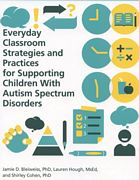
|
Everyday Classroom Strategies and
Practices for Supporting Children with Autism Spectrum Disorders. Jamie Bleiweiss, Lauren Hough & Shirley Cohen, $47.95
This practical approach to working with
students with autism spectrum disorders helps to demystify the processes needed
to help these students succeed and gives teachers the supports to plan
appropriately for them. Adopted by several schools and districts, this timely
resource clearly communicates how to create a classroom in which every learner
succeeds with specific and easy-to-implement strategies for students who
require minimal supports as well as those who require more intensive
interventions. In compliance with current trends in education, it incorporates
evidence-based practices, positive behavior supports, and uses Response to
Intervention. |
|
|
Executive Function in Education: From Theory to
Practice, 2nd Edition. Lynn Meltzer, editor, $46.95
This groundbreaking volume, now revised and updated, has
given thousands of educators and clinicians a deeper understanding of executive
function (EF) processes in typically developing children and those with
learning difficulties and developmental disabilities. The book elucidates how
PreK–12 students develop such key capacities as goal setting, organization,
cognitive flexibility, working memory, and self-monitoring. Exemplary practices
for supporting students with EF difficulties in particular content areas — reading,
writing, and math — are reviewed. New to This Edition:
- Updated throughout with a decade's worth of significant advances
in research, theory, and educational best practices.
- Chapter on early childhood.
- Chapter on embedding EF strategies in the curriculum.
- Expanded coverage of reading — chapters on recent fMRI research
findings; working memory and reading; and self-regulation and reading
comprehension.
|
|
|
Fine Motor Skills for Children with Down Syndrome: a
Guide for Parents and Professionals, 3rd Edition. Maryanne Bruni, $32.50 
The popular book, Fine Motor Skills for Children with
Down Syndrome is now available in a completely revised third edition. The
author, an occupational therapist and parent of an adult with Down syndrome,
describes how the characteristics of Down syndrome can impact the acquisition
and progression of fine motor skills. She presents a thorough overview of the
building blocks of fine motor development, from infancy through to adulthood:
- Early arm and hand control
- Stability, Bilateral coordination, Sensation, Dexterity
- Activities to build daily living skills for home and school
- Scissor skills and Pencil grasp development, pre-printing,
printing & cursive writing
- Keyboard skills, computer & tablet skills
- Dressing, grooming, and feeding skills
Throughout the book, the author suggests ways to
incorporate fine motor skill development opportunities into as many day-to-day
activities as possible, recognizing how impractical it is to constantly be in
"therapy" mode with a child. Suggestions for gift ideas are offered
in "Grandma's and Grandpa's list" at the end of each chapter.
With expanded and updated information on fine motor
skills and computer and personal electronic device use, keyboarding skills,
postural support, sensory processing, and the adult years, readers will have at
their fingertips a cornucopia of information and guidance to support the fine
motor development of children and adults. |
Back to top
|
FISH: Functional Independence
Skills Handbook. William Killion, $115.95 (Complete FISH
Kit includes the Assessment and Curriculum Handbook and 10 Assessment
Booklets)
The Functional Independence Skills
Handbook, or FISH, is used for determining a person's ability
to perform certain functional activities from daily life. It was
developed for special education teachers, para-educators, and parents
working with individuals with severe developmental disabilities.
The objective of the program is a direct increase in personal independence
in those with autism and other developmental disorders. This program
would also be beneficial for children with cognitive deficits, school
age through adult.
FISH is a criterion-referenced series
of 421 tasks. The assessment instrument and lessons are organized
according to seven domains: Adaptive Behavior Skills, Affective
(or Emotional) Skills, Cognitive Skills, Sensori-motor Skills, Social
Skills, Speech and Language Skills, and Vocational Skills.
|
|
|
Frequently
Asked Questions about Response to Intervention: a Step-by-Step Guide
for Educators. Roger Pierangelo & George Giuliani,
$41.95
Increasingly, teachers are learning about
the important role of Response to Intervention (RTI) in the success
of every child. RTI is a multifaceted approach that provides immediate,
relevant, and research-based services and interventions to students
in general, compensatory, and special education. Written by two
legal and special education experts, this concise, reader-friendly
guide introduces educators to the purpose, core principles, legal
basis, benefits, and application of this service delivery model. |
|
|
From Gobbledygook to Clearly Written Annual IEP Goals. Barbara Bateman, $32.95
Writing clear, measurable annual IEP goals is a difficult skill to master. This plain-speaking guide shows you how to write clean, objective, productive goals that will guide students toward success. |
Back to top
|
Getting the Most
Out of IEPs: an Educator’s Guide to the Student-Directed Approach. Colleen Thoma & Paul Wehman, $34.95
Student-directed IEPs are quickly gaining momentum in schools — the proven benefits include higher academic achievement, enhanced student motivation, and increased communication and self-advocacy skills for students with disabilities. Now for the first time, there's a book that gives elementary and high school educators in-depth how-to guidance on making student-directed IEPs work for students with a range of special needs.
Packed with practical advice, helpful examples, and IEP resources for students themselves, this guidebook puts into print the best ideas for developing meaningful student-directed IEPs while adhering to legal requirements and evidence-based practices. Teachers will learn how to support students—regardless of their current skills and abilities—as they increase their own level of direction across every facet of the IEP process.
|
|
Getting Started: iPads 4 Special Needs. Sami Rahman, $27.50
The iPad can be a very powerful tool for the special
needs user. This handbook addresses the everything you need to know — from
which iPad to buy, to the multitude of accessories that may be necessary for
the special needs user. This book will also guide you through goal setting,
basic and advanced set up options, finding apps, maintenance and
troubleshooting, and encouraging your user to interact with the iPad. |
|
A Guide to Duchenne Muscular Dystrophy: Information
and Advice for Teachers and Parents. Edited by Janet Hoskin, $29.95
This guide provides everything teachers and parents need
to know to support a child or young person with Duchenne Muscular Dystrophy
(DMD) at school and home. Medical experts and practitioners working with
children with Duchenne in schools give advice on learning and behavioural
concerns, physical management and the transition to adulthood.
Leading experts on DMD explain Duchenne and its impact in
easy-to-understand terms. Going beyond physical management, particular focus is
put on learning and behavioural issues, including speech delay and difficulty
learning to read, as well as common co-morbid conditions, such as ADHD, autism and
OCD. Raising aspirations, the book gives guidance on effective support in the
classroom and advice on the transition to adulthood, employment and independent
living. |
|
A Guide to Writing Social Stories™: Step-by-Step
Guidelines for Parents and Professionals. Chris Williams & Barry
Wright, $28.95
Social Stories™ are a widely used and highly effective
intervention for supporting children on the autism spectrum, but it can feel
overwhelming to follow all the rules put in place to create personalised
stories. Developed with the input of parents and professionals, and informed by
new Social Stories research, this is a comprehensive, clear, easy step-by-step
guide to writing effective personalised Social Stories™ that give children social
information, creating many benefits for them.
The book includes many examples of real Social Stories
created for children by parents and teachers working together, and handy
downloadable checklists that highlight the essential components of a Social
Story, helping to ensure that each story you write achieves the best possible
results. |
Back to top
|
Helping Children to Improve Their Gross Motor Skills:
the Stepping Stones Curriculum. Rachel White, $49.95
Help children with motor coordination difficulties to
develop their gross motor skills in a fun way with this guided programme for
children and young people aged 5-18. Activity worksheets provide detailed
descriptions of how gross motor tasks can be accomplished through incremental
stages, culminating in the achievement of the specific task. The step-by-step
programme is divided into two sections:
- Learning basic skills, which includes balance, jumping, climbing,
skipping, ball skills, riding a bike and more
- Developing specific sports skills, which includes football,
badminton, basketball, netball, tennis, bowling and more.
The Stepping Stones Curriculum will enable adults to
chart the progress of a child and allow children to become engaged in mastering
motor coordination skills. Supplementary aids such as warm up and cool-down
activity sheets, an initial assessment tool and a certificate of achievement
will help parents and professionals to deliver the programme effectively at
home or at school. |
|
Identifying Children
with Special Needs: Checklists and Action Plans for Teachers.
Glynis Hannell, $49.95
If you’re a general education teacher
with little or no experience in special education, identifying children
and adolescents with potential disabilities may seem an impossible
task. Glynis Hannell offers guidelines to help educators quickly
recognize and categorize the specific characteristics of autism
spectrum disorders, emotional-behavioral disorders, cognitive disabilities,
speech or language impairment, health-related disabilities, and
more. By identifying and understanding specific disabilities, teachers
can then use specific tools to ensure that all students receive
the services they need to succeed. |
|
Identifying Special Needs: Checklists
for Profiling Individual Differences, 2nd Edition. Glynis Hannell, $50.50
Drawing from her experience as an
educational psychologist, and special education teacher, Glynis Hannell offers
guidelines to help teachers quickly recognize and categorize the specific
characteristics of developmental disorders, autism spectrum disorders,
emotional-behavioural disorders, specific learning disorders, sensory
impairments and other forms of special need. The practical checklists and
resources in this fully revised new edition help both classroom and specialist
teachers to:
- Screen any student for possible special needs
- Understand the causes and characteristics of
various types of special needs
- Request and prepare for an intervention or IEP
team meeting
- Link classroom observations to diagnostic
criteria used by specialists
- Create accurate and comprehensive profiles for
individual students
- Record each student’s unique pattern of
development within a special needs ‘label’
- Quickly record important information and avoid
writing time-consuming reports
- Coordinate information from several teachers or
professionals
- Monitor progress and track significant changes
over time
- Involve parents in observing and discussing
their child’s pattern of strengths and challenges
- Plan effective, inclusive intervention in the
classroom setting
- Follow up with recommended further reading,
websites and professional references
Recognizing special needs and
identifying each student’s unique profile of positive attributes and
difficulties enables teachers and other educational professionals to ensure
that all their students receive the support they need to succeed. |
Back to top
|
|
The IEP Checklist: Your Guide to Creating Meaningful
and Compliant IEPs. Kathleen Winterman & Clarissa Rosas, $48.50
How can you design effective IEPs that improve student
outcomes and meet legal requirements? This one-stop IEP guide has the
answers your team needs to create great IEPs and put them into action. You'll
start with a solid introduction to IEPs: their purpose, their major components,
and the legal mandates they need to meet. Then you'll get a comprehensive
framework for IEP development, featuring a unique, in-depth checklist that
breaks the whole IEP process into small, manageable steps and walks you through
each one. Packed with invaluable planning tips, vivid examples, and practice
activities, this book is your whole school team's step-by-step guide to
meaningful, legally compliant IEPs that help students reach their goals. |
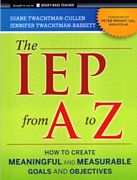
|
The IEP from A to Z: How to Create Meaningful and Measurable Goals and Objectives. Diane Twachtman-Cullen & Jennifer Twachtman-Bassett, $35.95
This step-by-step guide shows teachers and parents how to get the right education plan in place for students with ADHD, Autism/Asperger's, Emotional/Behavioral Disturbance, and related conditions.
- Provides easy-to-understand explanations of the special education process along with a wealth of sample effective IEPs
- Explains what is most important for educators and parents to keep in mind during IEP development
- Provides content area-specific sample goal and objective templates, general teaching tips for maintaining the IEP, and useful resources
From nationally recognized experts in the special education field, this book guides readers through the process of writing thoughtful, intelligent Individualized Education Plans that deliver high-quality, need-based educational programming to exceptional students.
|
Back to top
|
Individualized
Supports for Students with Problem Behaviors
Designing Positive Behavior Plans. Linda Bambara & Lee Kern,
$65.95
Practical and comprehensive, this book focuses on the nuts and bolts
of designing positive behavior support plans for students with such
disabilities as mental retardation, autism, learning disabilities,
and emotional/behavioral disorders. Strategies are provided for addressing
individual behavioral problems at all levels of severity. Filled with
illustrative examples, the book shows how to conduct a functional
assessment and develop an overall support plan, using a team-based
approach … Featuring self-check questions to facilitate learning and
problem solving, this is an invaluable classroom text and professional
guide. |
|
Inspiring and Creative Ideas for Working with
Children: How to Build Relationships and Enable Change. Deborah Plummer,
$27.95
Employing a range of innovative and creative ideas, this
book is full of tips to engage children and promote their wellbeing. Children
are vulnerable to low self-esteem, stress and anxiety because they are still
growing and learning. This book looks at what we can do to minimise children's
vulnerability to issues such as these, help them to build emotional resilience
and teach them effective strategies for dealing with life's ups and downs. The
book offers a host of different approaches that adults can use with children,
including image-making, storytelling and puppetry. Chapters are brought to life
with the voices of parents and professionals describing how these techniques
worked for them. They also include guidance on how the principles can be used
by professionals in the home, in schools or in therapeutic settings. |
|
Instructional
Practices for Students with Behavioral Disorders: Strategies for
Reading, Writing, and Math. J. Ron Nelson, Gregory Benner
& Paul Mooney, $28.50
Presenting a broad range of instructional
programs and practices that are proven effective for students with
behavioral disorders for K-3 teachers and special educators. Described
are clear-cut strategies for promoting mastery and fluency in early
reading, writing, and math, while tailoring instruction to each
student's needs. A special chapter outlines instructional management
procedures for enhancing student engagement and promoting positive
behavior. |
Back to top
|
Involving Parents of Students with Special Needs: 25
Ready-to-Use Strategies. Jill Dardig, $30.99 (PK - 12)
Research has shown that establishing strong communication
link with parents and promoting family involvement can have positive and
tangible effects on a student's success in school. In this teacher-friendly
resource, Jill Dardig provides 25 read-to-use techniques for involving parents
in the education of children with a wide range of learning needs — including
cognitive, emotional/behavioural, social, sensory, and physical disabilities. |
|
Literacy for Visual Learners: Teaching Children with
Learning Differences to Read, Write, and Communicate. Adele Devine, $49.95
This book takes a fresh look at approaches to teaching
reading, writing and communication skills. It presents a wealth of innovative
ideas specifically designed to support visual learners, including those with
autism spectrum conditions and special educational needs.
Some children are more responsive to visual stimulation than spoken words, and
this book shows how to engage these children in literacy lessons by using
strategies that cover everything from the latest assistive technology to
getting creative on a limited budget. There are tips for sharing stories with
children who find it hard to sit still, supporting reluctant writers, enabling
the pre-verbal child to answer questions and helping the child who never stops
talking to develop listening skills. The strategies are supported by practical
resources, examples and case studies, to show how to instil in children the
confidence to create and share their thoughts.
This is a must-have resource for special education teachers and coordinators,
as well as speech and language therapists, looking for new strategies for
teaching literacy. |
|
Making Math Accessible to Students with Special Needs: Practical Tips and Suggestions, Grades K-2. $33.50
Making Math Accessible to Students with Special Needs: Practical Tips and Suggestions, Grades 3-5. $33.50
Making Math Accessible to Students with Special Needs: Practical Tips and Suggestions, Grades 6-8. $33.50
Making Math Accessible to Students with Special Needs: Practical Tips and Suggestions, Grades 9-12. $33.50
Increase your capacity to make mathematics accessible to all students. These comprehensive manuals offer tools and guidance that everyone in mathematics education can use to increase confidence and competence. Chapters address critical topics such as research-based instructional best practices, and alternative instruction and assessment practices. Reflective questions and tasks make these perfect for self-guided or group study. Appendices offer sample answers and additional supports. |
|
|
|
Back to top
|
Meeting Special Educational Needs in Secondary Classrooms:
Inclusion and How to Do It, 2nd Edition. Sue Briggs, $57.95
There are greater numbers of children with Special
Educational Needs and Disabilities (SEND) now attending mainstream schools.
This fully updated and revised edition of Meeting Special Educational
Needs in Secondary Classrooms is written by an experienced teacher,
adviser and consultant and explains the challenges that these children face.
This is a practical book full of guidance for teachers and teaching assistants
who support children with SEND in mainstream secondary classrooms. Now fully
updated this book:
- covers all aspects of teaching children with SEND, including
planning, teaching and learning
- promotes successful communication between teachers, parents and
students
- contains photocopiable resources and templates
With practical guidance on how to make the curriculum
more accessible for children with SEND, this book will help teachers and TAs
work together to support pupils with Special Educational Needs and Disabilities
more effectively. |
|
Moment to Moment: a Positive Approach to Managing
Classroom Behavior. Joey Mandel, $24.95
Insightful and empowering, this book is based on the
premise that some children need extra help and patience in developing social
skills. It shows teachers how to build on these crucial skills, ranging from
the ability to control speech and movement, through improving attention and
concentration, to the ability to adapt to the social environment of the
classroom. It gives teachers the tools to help children develop stronger
character, sense of self, and emotional well-being, to give them the skills
they need to deal with the emotional challenges they meet in school. Classroom
games and activities to teach and support all students in key social skills and
engagement complement this important book. |
Back to top
|
The
Neuropsychology of Mathematics: Diagnosis and Intervention.
Steven Feifer & Philip De Fina, $79.95
The Neuropsychology of Mathematics explores how young children learn and acquire basic mathematical
skills from a brain-based educational perspective. There are discussions
on three primary ways in which numbers are formatted in the brain,
as well as the relationship between anxiety and mathematical performance
during classroom learning situations.
The Neuropsychology of Written Language Disorders:
Diagnosis and Intervention. Steven Feifer & Philip
De Fina, $79.95
The Neuropsychology of Written Language
Disorders discusses both language based and non-language based
written language disorders from a brain-based education model of
learning. It is intended for school psychologists, occupational
therapists, speech pathologists, special educators and school administrators. |
|
|
100 Learning Games for Special Needs
with Music, Movement, Sounds and...Silence. Johanne
Hanko, $31.95
Games and activities are a great way for
children with special needs to learn important skills. This book provides
inspiration and guidance for special education teachers, teaching assistants,
parents and carers on how to use lively and engaging play ideas to foster
learning and development.
Targeting key skills including
listening, self-awareness, movement, creative thinking and relaxation, each
game has been developed with the capabilities of children with special needs in
mind. The appropriate age group is clearly identified, and possible variations
for different abilities are provided. All of the instructions are easy to
follow and there are cheerful illustrations throughout. Using music, dance,
art, word games and breathing exercises, this book is packed with creative and
enjoyable games that make learning fun. |
|
PANDAS and PANS in School Settings: a Handbook for
Educators. Edited by Patricia Rice Doran, $30.95
PANDAS (Pediatric Autoimmune Neuropsychiatric Disorders
Associated with Strep) and PANS (Pediatric Acute-Onset Neuropsychiatric
Syndrome) occur when an abnormal immune response produces brain inflammation,
leading to unusual psychological symptoms in children. Symptoms can include
OCD, tics, ADHD, anxiety disorders, sensory issues and marked personality
changes.
This practical handbook explains how educators can
distinguish between these symptoms and pre-existing conditions, and offers
strategies for supporting students with PANDAS and PANS in school settings.
Contributions from experts provide educators with the understanding needed to
be able to collaboratively identify PANDAS and PANS, and carry out effective
interventions. As the rate of incidence of PANDAS and PANS increases, this book
will be an essential resource for school staff in getting to grips with these
complex disorders and overcoming the challenges they present. |
Back to top
|
Paraeducator’s Resource Guide. Nancy French, $13.95 (laminated resource guide)
This reference gives you, the
paraeducators, with valuable information about roles, responsibilities, job
supervision, classroom instruction, as well as positive behavioral interventions
and support. It also guides you to ask the right questions when you need more
detailed specific information. |
|
The Paraprofessional's Guide to Effective Behavioral
Intervention. Betty Ashbaker & Jill Morgan, $53.95
The Paraprofessional’s Guide to Effective Behavioral
Intervention is a comprehensive guide to appropriate behavioral
strategies in the classroom, based on the Least Restrictive Behavioral
Intervention (LRBI) and Positive Behavioral Intervention Strategies (PBIS).
This highly practical book provides:
- an increased understanding of the processes underlying student
behavior in the classroom, including motivation
- a wide range of strategies for establishing and promoting
positive behavior, as well as counteracting and reducing negative behaviors
- skills related to nationally recognized standards for
paraprofessional competence
- an understanding of widely accepted principles and practices such
as Response to Intervention (RTI)
The Paraprofessional’s Guide to Effective Behavioral
Intervention illuminates research-based, practical strategies shown to
be effective in a wide range of educational settings and which can be
implemented immediately and with confidence. |
Back to top
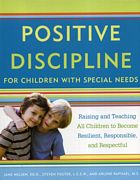
|
Positive Discipline for Children with Special Needs: Raising and Teaching All Children to Become Resilient, Responsible and Respectful. Jane Nelsen, Steven Foster & Arlene Raphael, $20.95
Every child deserves to lead a happy and fulfilling life. For parents and teachers of children with special needs, helping their child to not only negotiate daily challenges, but to live fulfilling, meaningful lives, can be the most difficult challenge they will face. Over the years, millions of parents and teachers have come to trust Jane Nelsen’s classic Positive Discipline series for its consistent, commonsense approach to childrearing. Now, the bestselling series addresses the specific challenges that parents and teachers of children with special needs face, and offers them straightforward advice for supporting them in positive ways. In these pages are practical solutions to challenges such as:
Learning to look beyond diagnostic labels • Believing in each child's potential regardless of his/her stage of development • Helping children integrate socially and interact with their peers • Coping with the frustration that inevitably occurs when a child is being difficult • Strengthening a child's sense of belonging and significance • And Many More! |
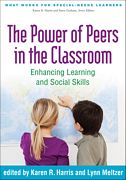
|
The Power of Peers in the Classroom: Enhancing
Learning and Social Skills. Edited by Karen Harris & Lynn Meltzer,
$47.50
Peer support and social relationships have a tremendous
influence on development, motivation, and achievement for all students,
including struggling learners and those with disabilities. This highly practical
book is one of the few resources available to guide classroom teachers and
special educators in the application of peer-assisted instructional strategies
in grades K-12. Expert contributors describe evidence-based approaches for
building students' skills in reading, writing, math, and other content areas,
as well as social competence and executive functioning. Sample lessons and more
than a dozen reproducible tools are provided. Purchasers get access
to a Web page where they can download and print the reproducible materials. |
|
Practical Mathematics for Children
with an Autism Spectrum Disorder and Other Developmental Delays. Jo Adkins & Sue Larkey, $49.95
This book provides practical strategies
and tools for teaching key mathematics concepts to children with an autism
spectrum disorder and other developmental delays. The authors emphasize the
importance of incorporating a child's special interest into learning in order
to help them engage fully with new concepts. Topics covered include colours,
shapes, categories, numerals, sequencing, addition and subtraction and using
money, and the book includes worksheets and activities for incorporating
mathematics into daily living skills. This is an essential resource for
teachers, teaching assistants and parents. |
Back to top
|
|
Promoting Successful Transition to Adulthood for
Students with Disabilities. Robert Morgan & Tim Riesen, $48.50
Comprehensively addressing the challenges of transition,
this book provides practical knowledge and tools geared toward real-world
educators. It presents clear guidelines for all aspects of team-based
transition planning for individuals with various levels of disability,
illustrated with vignettes of three secondary students who are followed
throughout the book. The authors describe evidence-based practices for
conducting assessments and promoting optimal outcomes in the areas of
employment, postsecondary education, and independent living. Keys to family
involvement, self-determination, interagency collaboration, and problem solving
are highlighted. Several reproducible forms can be downloaded and printed in a
convenient 8½" x 11" size. |
|
Recognize, Respond,
Report: Preventing and Addressing Bullying of Students with Special Needs. Lori Ernsperger, $39.50 (K-12)
Bullying in schools is a national problem that affects a
high percentage of students with special needs. This ready-to-use guidebook
gives K–12 educators, administrators, and school counselors the research-based
interventions they need to stop bullying in its tracks — and prevent it before it
starts.
Using a simple framework of 3 Rs (Recognize, Respond, and Report),
you'll master the core components of preventing and addressing bullying and
disability-based harassment at the district level, classroom level, and
individual level. Practical, proven strategies and tools blend with heartfelt,
real-world advice from students who've experienced bullying themselves. An easy
fit with your existing initiatives, whether you use PBIS or a commercial
anti-bullying program, this essential resource will help you create a safe and
secure learning environment for all students to reach their full
potential. |
Back to top
|
The Sensory Detective Curriculum Discovering Sensory
Processing and How It Supports Attention, Focus, and Regulation Skills. Paula
Aquilla, $33.50 
Understanding our sensory processing ability helps us to
understand our likes, dislikes, and regulation style; i.e., the strategies we
use to help keep ourselves in a calm, alert state. The calm, alert state is the
state necessary for learning! Knowing how to stay regulated is a life skill.
This ability enables us to function in different environments, in different
situations, and with different people.
The Sensory Detective Curriculum is a resource
that can be used in a school setting to enable children to learn more about
themselves and others. It meets learning goals in science and social studies
and can provide a platform to discuss how we behave and communicate with each
other. Opening this discussion can help us understand how tensions can rise,
how bullying can happen, and how children in our own classroom can feel lonely,
isolated and misunderstood. The Sensory Detective Curriculum enables
students to discover sensory processing and how it supports attention, focus
and regulation skills. Learning adventures include: the neurology of sensory
processing, how sensory processing supports the nervous system to pay attention
and focus, how emotion is connected to sensory processing and regulation. Each
chapter has fun activities for students to not only deepen their understanding
but to apply this understanding to their own classroom. |
|
Show Me! A Teacher's Guide to Video Modelling. Carol Dittoe & Heather Bridgman, $27.95
With the technology we have today (tablets, smartphones,
applications), implementing video modeling is easier than ever! This book is
meant to inspire readers to think about how they can use video modeling by
providing many real-life examples of students who have used and found benefits
from watching video to learn social skills, positive behaviors, and academics.
A helpful planning guide is provided to help teams get started and more easily
implement the video-modeling strategy. |
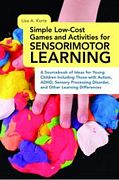
|
Simple Low-Cost Games and Activities for Sensorimotor
Learning: a Sourcebook of Ideas for Young Children Including Those with Autism,
ADHD, Sensory Processing Disorder, and Other Learning Differences. Lisa Kurtz,
$29.95
This practical sourcebook is packed full of fun, low-cost
games and activities that encourage the development of motor skills,
coordination and sensory tolerance in young children. Using materials that are
readily-available in most households or that can be purchased or homemade at a
very low cost, these games and activities are appropriate for all children,
including those with autism, ADHD, Sensory Processing Disorder, and other
learning challenges. The book includes clear descriptions of how to carry out
each activity, helpful illustrations, and ways to adapt activities according to
the child's individual needs. In addition, a comprehensive reference guide to
the activities enables easy searching for games suited to the development of
particular skills.
This sourcebook is the key to easy-to-understand,
low-cost, and effective games and activities that will support the development
of sensorimotor skills. It is a useful tool for parents, carers, therapists,
and teachers of children with or without special needs. |
Back to top
|
63 Tactics for Teaching Diverse Learners Grades 6-12. Bob Algozzine, Pam Campbell & Adam Wang, $30.99
This collection of evidence-based instructional
strategies enables general and special education teachers, novice or
experienced, to address the learning needs of all students in diverse,
inclusive classrooms. The authors provide a practical, research-based teaching
model that focuses on planning, managing, delivering, and evaluating
instruction for middle and secondary students with or without disabilities. |
|
|
Social Skills Games & Activities
for Kids with Autism. Wendy Ashcroft, Angela
Delloso & Anne Marie Quinn, $30.95
SOCIAL SKILLS GAMES AND ACTIVITIES FOR
KIDS WITH AUTISM provides complete instructions for using fun, engaging
games and activities to teach social skills to children with autism spectrum
disorders. The games include directions for assessing skills such as asking for
toys, getting the attention of others, reading nonverbal gestures,
understanding perspectives, and cooperating to solve problems. Using the
principles of Applied Behavior Analysis, the book takes teachers through
motivating, prompting, shaping, modeling, and reinforcing social skills while
playing the games and helping students learn to participate in other activities
such as demonstrating the social skill in role plays and the natural
environment. Perfect for teachers struggling to help their students with autism
learn to interact socially with their peers, these games are sure to become a
much-loved part of students’ daily routines. |
|
|
Special Education Case Studies for Ontario Classrooms.
Kimberly Maich & Randy Hill, $49.95 
Special Education Case Studies is an exciting new
resource for teacher-candidates as well as fully certified teachers preparing
to teach in inclusive classrooms in Ontario. Each chapter is composed of five original
cases demonstrating the practices and processes of Special Education. Spanning
kindergarten to high school graduation, these well-written stories provide a
practical and realistic snapshot of what teaching in an inclusive classroom in
Ontario really looks like.
This book is a supplemental text for special education
courses at universities in Ontario, either through education departments or
through additional qualification courses. |
Back to top

|
Special Education
in Ontario Schools, 7th Edition. Sheila Bennett & Don
Dworet with Ken Weber, $43.95 
The 2013 edition of this terrific resource has been fully updated
to reflect the changes and continuing issues in Ontario's special
education system since the 2008 edition. An indispensable guide for
all educators in Ontario schools, this is a hugely practical, insightful
and inspiring look at identifying and developing the strengths of
children with differing abilities and needs. |
|
|
The Special Educator’s
Toolkit: Everything You Need to Organize, Manage, & Monitor
Your Classroom. Cindy Golden, $43.95
Reduce your stress and support student
success with this practical toolkit for whole-classroom organization. A
lifesaver for special educators in any K–12 setting, this book and CD-ROM set
will help teachers expertly manage everything, from schedules and paperwork to
student supports and behavior plans with this innovative approach to creating
effective classrooms for students with all types of disabilities. Special
educators will get step-by-step, ready-to-use guidance on managing six key
aspects of their daily work:
- Environment. Make the most of every inch of
classroom space! Clean out clutter, arrange furniture to improve traffic flow,
and construct classroom zones, work stations, and bulletin board displays that
support learning.
- Communication. Implement low-cost
communication supports that meet student needs. Make simple picture symbol
books, interactive schedules, labels for classroom areas and objects, and more.
- Teaching Methods and Materials. Determine
student needs, create schedules, simplify the IEP process, and pinpoint the
best methods for teaching academic, vocational, behavioral, social, and life
skills.
- Behavioral Systems. Organize a successful
behavioral system that motivates students, helps them improve behavior and
social skills, and uses positive reinforcement techniques.
- Data and Paperwork. Learn the secrets to
creating a simple, logical, highly efficient system for managing paperwork—so
more time can be spent on teaching.
- Staff and Home Supports. Build trusting,
respectful relationships with classroom staff and parents with stress-free
strategies like team meetings and home communication notebooks.
For each of these critical areas, special educators will discover dozens of
proven strategies, vivid examples, and clever tips and tricks to help them make
immediate improvements in their classroom. The book includes a CD-ROM with
more than 60 printable forms and tools to support learning, safety, and
positive behavior. This is the ultimate guide for every special educator, from
the first-year teacher setting up a new classroom to the seasoned veteran who
wants a down-to-earth guide to current best practices. |

|
Specific Learning Difficulties: What Teachers Need to
Know. Diana Hudson, $25.95
This book clearly explains what Specific Learning
Difficulties (SpLD) are, and describes the symptoms of conditions most commonly
encountered in the mainstream classroom: dyslexia, dyspraxia, dyscalculia,
dysgraphia, Autism Spectrum Disorder, ADHD, and OCD. The author provides an
overview of the strengths and weaknesses commonly associated with each of these
conditions, as well as practical suggestions for modifying teaching materials
and methods to make learning enjoyable, effective and accessible for students.
There are also dedicated chapters on helping students with SpLDs to develop
effective revision skills and exam techniques. |
Back to top
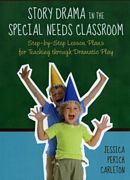
|
Story Drama in the Special Needs
Classroom: Step-by-Step Lesson Plans for Teaching through Dramatic Play. Jessica Perich Carleton, $31.95
Introducing drama to the learning
experience is guaranteed to enrich a child's development, and is an especially
effective approach for children with special educational needs, including those
with autism spectrum disorders. This practical handbook offers teachers an
array of simple and easy-to-implement theatrical techniques that will enhance
students' learning and encourage artistic expression.
The author demonstrates how drama can be
applied to a diverse range of school subjects and recreational settings. 'The
Little Red Hen', for example, covers themes that are relevant to literacy
(rhyming and rhythm), maths (counting seeds), science (discussing farming), and
art lessons (designing costumes). Step-by-step lesson plans take teachers
through every aspect of running fun and engaging story dramas, including warm
ups, movement, songs and props. Handy tips throughout suggest ideas for
developing the plays further and ways to adapt them according to the needs of
the group. |
|
|
Strategies to Support Children with Autism and Other
Complex Needs: Resources for Teachers, Support Staff, and Parents. Christine
Macintyre, $50.30
Strategies to Support Children with Autism and other
Complex Needs bridges the gap between explaining what autism is
and finding ways to interact through having a balance of play activities
interspersed with more formal teaching of skills of everyday living. This
highly practical text provides a bank of strategies that are specially designed
to be matched to the developmental status of each child. These strategies are
endorsed by academics who have monitored the children’s responses in
communicating, pretending, playing, moving, and singing and describe how the
children have responded positively over time. This book covers a variety of
topics such as:
- The importance of play for enhancing learning for children with
autism and other complex needs
- Evaluating different ways of developing communication
- Transferring learning from one environment to another to aid
memorizing
- Understanding the impact of sensory hypo and hyperactivity on
children’s learning
- Developing a ‘Theory of Mind’
- The importance of movement, music and having fun
Observation and assessment schedules are provided, along
with clear and helpful evaluation forms which show staff in primary and early
years settings how children on the autistic spectrum can be helped to make
meaningful and encouraging progress. |
Back to top
|
|
Supporting Children with Autistic Spectrum Disorders,
2nd Edition. Elizabeth Morling & Colleen O'Connell, $47.50
This practical resource contains a wealth of valuable
advice and tried-and-tested strategies for identifying children and young
people with Autistic Spectrum Disorders (ASD). This fully updated text
describes the different types of difficulties experienced by pupils with ASD
and helps practitioners to understand their diverse needs. This fully updated
new edition explores key topics, including:
- organizing the classroom and support staff
- home-school liaison and working with siblings
- transition to adulthood
- independence skills
- whole school implications
This invaluable guide provides guidance and practical
strategies for teachers and other professionals, helping them to feel more
confident, and be more effective in supporting learners in a variety of
settings. For professional development, this book also provides materials for
in-house training sessions, and features useful checklists, templates and
photocopiable/downloadable resources. |
|
|
Supporting Children with Cerebral Palsy, 2nd Edition. Rob
Grayson, et al, $47.50
Offering practical tips and tried-and-tested strategies
from professional practitioners, this accessible guide provides advice on how
to meet the needs of young people with cerebral palsy. This new edition
presents all of the information practitioners will need to know to deliver
outstanding provision for young people with cerebral palsy and support the
inclusion of children and young people with cerebral palsy into mainstream
schools. The far-reaching advice found within this guide includes:
- Planning for a pupil with cerebral palsy
- Accessing the curriculum, including specific advice on each
subject area
- Developing independence skills
- Liaising between home and school
- Making the transition into adulthood
With accessible materials, such as checklists, templates
and photocopiable resources, this up-to-date guide will enable teachers and other
professionals to feel more confident and effective in the support they can
provide. |
|
|
Supporting Pupils on the Autism Spectrum in Primary
Schools: a Practical Guide for Teaching Assistants. Cary Canavan, $57.50
Written to meet the needs of teaching assistants and
learning support assistants, this book provides a practical toolkit for
supporting students on the autistic spectrum in mainstream secondary schools.
The book offers a clear, jargon free explanation of
autism spectrum conditions and examines the difficulties arising from these
conditions and how they can impact on students’ learning. Addressing issues
which arise on a daily basis, it is full of practical advice and strategies for
supporting students socially and academically across all areas of the
curriculum. Features include:
- templates to scaffold students’ comprehension and learning in
different subject areas
- forms to help with information collection and evaluation
- advice on supporting students through examinations
- examples and case studies to illustrate how the strategies
described work in practice
Packed with photocopiable resources that can be adapted
to suit individual students’ needs, this book is essential reading for teaching
assistants that want to help their students’ on the autism spectrum to reach
their full potential. |
Back to top
|
|
Supporting Pupils on the Autism Spectrum in Secondary
Schools. Cary Canavan, $53.95
Written to meet the needs of teaching assistants and
learning support assistants, this book provides a practical toolkit for
supporting students on the autistic spectrum in mainstream secondary schools.
The book offers a clear, jargon free explanation of
autism spectrum conditions and examines the difficulties arising from these
conditions and how they can impact on students’ learning. Addressing issues
which arise on a daily basis, it is full of practical advice and strategies for
supporting students socially and academically across all areas of the
curriculum. Features include:
- templates to scaffold students’ comprehension and learning in
different subject areas
- forms to help with information collection and evaluation
- advice on supporting students through examinations
- examples and case studies to illustrate how the strategies
described work in practice
Packed with photocopiable resources that can be adapted
to suit individual students’ needs, this book is essential reading for teaching
assistants that want to help their students’ on the autism spectrum to reach
their full potential. |
|
|
A Survival Guide for New Special Educators, Grades
K-12. Bonnie Billingsley, Mary Brownell, Maya
Israel & Margaret Kamman, $35.95
Drawing on the latest research on
special educator effectiveness and retention, this comprehensive, go-to
resource addresses the most pressing needs of novice instructors, resource
teachers, and inclusion specialists. This highly practical book is filled with
checklists, forms, and tools that special educators can use every day to help
ensure that all special needs students get the rich, rewarding education they
deserve. |
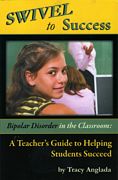
|
Swivel to Success: Bipolar Disorder in the Classroom. Tracy Anglada, $18.95
A teacher’s guide to understanding and helping students with bipolar disorder succeed at school. |
Back to top
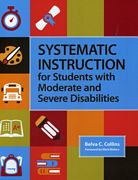
|
Systematic Instruction
for Students with Moderate and Severe Disabilities. Belva Collins,
$63.50
To ensure the best outcomes for students
with moderate and severe disabilities, K–12 educators need to understand what
constitutes good instructional practices and how to apply them in any
classroom, with any curriculum. All the how-to guidance they need is in this
accessible text on systematic instruction, a highly effective teaching approach
rooted in applied behavior analysis.
This one-of-a-kind textbook fully prepares teachers to use systematic
instruction procedures to link core content with critical life skills. Future
educators will discover evidence-based methods that help them:
- collect accurate screening and baseline
data before instruction
- effectively use specific systematic
instruction procedures
- make instruction more efficient by weaving
nontargeted information into lessons
- improve students' communication
skills through naturalistic language strategies
- expertly organize and deliver small-group
systematic instruction
- enhance instruction with assistive
technology
- plan successful instructional
schedules for students across settings and teachers
- maximize instruction time by involving
peers, paraprofessionals, and service delivery personnel
- help students maintain new skills and
generalize them to other settings
An ideal textbook, this student-friendly book includes sample lesson plans,
chapter objectives, reflection questions, and a glossary. And the practical
materials—including 20 blank data collection sheets and quick step-by-step
charts of instruction procedures—make this an invaluable resource for
in-practice educators. A comprehensive guide to the why and how of systematic
instruction, this is the accessible text teachers need to succeed in inclusive
classrooms and improve outcomes for students with moderate and severe
disabilities. |

|
Talkabout Sex & Relationships 1: a Programme to
Develop Intimate Relationship Skills. Alex Kelly & Emily Dennis, $72.70
Talkabout Sex & Relationships 1 is a
comprehensive toolkit for all therapists, educators and support staff who
deliver relationship education to people with special needs. It is intended
primarily to support groupwork but activities can be easily adapted to suit the
needs of individuals with varying abilities.
The resource emphasises the importance of happy, healthy
and positive relationships. It looks at the life cycle of a relationship from
finding a partner, coping with problems, staying safe and maintaining a
relationship to dealing with the potential ending of a relationship. This
toolkit is the first in a two volume set, the second of which will focus on
sex. |
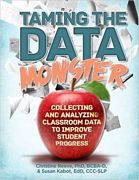
|
Taming The Data Monster: Collecting and Analyzing
Classroom Data to Improve Student Progress. Christine Reeve & Susan
Kabot, $45.95
Faced with increasing demands for accountability, teachers are having to base
their instructional decisions and choice of interventions on data on student
performance. This book shows how to make this otherwise daunting task much more
manageable by means of case studies and countless evidence-based forms and
graphs. Although this book often refers to students and classrooms, the
data collection techniques are applicable to a wide range of environments,
including clinics, job-training and actual job sites, and homes. In
addition, the data collection tools and procedures are relevant for use with a
wide range of ages, from toddlers to adults. |
Back to top
|
|
Teaching Adolescents with Autism: Practical Strategies
for the Inclusive Classroom. Walter Kaweski, $22.95
Award-winning educator Walter Kaweski offers secondary
teachers practical strategies and heartfelt insights based on his extensive
experience as an autism specialist, inclusion coordinator, and father of a son
with Asperger syndrome. Students with special needs often require extra support
as they adjust to middle and high school and the changes that accompany
adolescence. Without support, this time can be overwhelming. TEACHING
ADOLESCENTS WITH AUTISM offers hundreds of valuable ideas to help support
students with diverse needs.
Each chapter offers numerous personal stories that illustrate and reinforce
strategies in a tangible way. Important concepts are augmented with bulleted
lists, tables, figures, photographs, and cartoons drawn by a student with autism.
This unique book takes the mystery out of teaching adolescents with autism and
inspires teachers to appreciate the individuality of each student. |
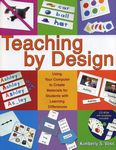
|
Teaching by Design:
Using Your Computer to Create Materials for Students with Learning
Differences. Kimberly Voss, $47.50
Teaching by Design shows readers
how to use the computer to design meaningful educational materials
for children and adults with special needs. A synthesis of computer
graphics, education, and crafting, this book represents the author’s
considerable expertise in customizing educational materials for
her daughter with multiple disabilities as well as teaching other
parents and teachers to create them too. Full of instructions for
designing and adapting materials and strategies for using them,
including a time-saving CD-ROM of templates, Teaching by Design
is useful to parents and teachers of students of all ages with a
wide range of disabilities. Design and customize lotto boards, interactive
spelling cards, game pieces, playing cards, matching games, menus,
fill-in-the-blank decals, handwriting transparencies, and more,
to teach visual perception, math, language, communication, reading,
handwriting, and self-help skills. |

|
Teaching Disability Sport, 2nd Edition. Ronald Davis, $54.95
This book and DVD package guides readers through the stages of program planning, implementation, teaching assessment and evaluation of a disability sports curriculum. Teachers can choose from more than 150 games and activities in seven sports, all cross-referenced to functional profiles. The DVD contains video clips of activities as well as assessment forms and other reproducible materials. |
Back to top
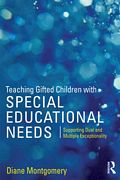
|
Teaching Gifted Children with Special Educational
Needs: Supporting Dual and Multiple Exceptionality. Diane Montgomery,
$57.95
Children with both giftedness and special educational needs are
often found in the mainstream classrooms. This essential resource provides an
overview of existing knowledge about dual and multiple exceptionality (DME),
examining the needs of gifted and talented children from both the class
teacher’s and SENCo’s perspectives. Diane Montgomery explores both the
specialist interventions that some children will need at least for part of
their school life, as well as the general inclusive provision that every school
can develop to meet the needs of all children. Focusing on evidence-based
identification throughout, chapters in this accessible book cover:
- An analysis of the terms ‘giftedness and talent’ and the
different methods that can be used for identifying them and assessing their
limitations
- Identifying and supporting a range of difficulties, syndromes
and disorders such as dyslexia, dyscalculia, DCD, ASD, ADHD and SEBD
- How to manage classroom behaviour, improve school ethos and
create a DME-friendly school through inclusive teaching and learning
This invaluable resource will assist you in creating a DME
friendly school, help to integrate learners with a range of difficulties and
enable them and others to learn. |
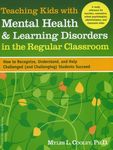
|
Teaching Kids
with Mental Health & Learning Disorders in the Regular Classroom:
How to Recognize, Understand, and Help Challenged (and Challenging)
Students Succeed. Myles Cooley, $51.99
When students have mental health issues and learning problems,
how can educators recognize the symptoms, respond appropriately,
and meet students’ learning needs while preventing or addressing
disruptive behaviors?
Written by a clinical psychologist, this user-friendly guide describes
mental health and learning disorders often observed in school children,
explains how each might be exhibited in the classroom, and offers
expert suggestions on what to do (and sometimes what not to do).
The book looks at students with:
- Anxiety Disorders including Generalized
Anxiety Disorder (GAD); Obsessive Compulsive Disorder (OCD); Post
Traumatic Stress Disorder (PTSD) and School Refusal
- Depression and Bipolar Disorder
- Communication Disorders including
difficulties with articulation; Receptive and Expressive Language
Disorder; stuttering and social communication problems (also known
as Pragmatic Language Disorder)
- Learning Disabilities including reading,
math and writing
- ADHD
- Disruptive Behavior Disorders
- Asperger’s Syndrome
- Tourette Syndrome
- Eating Disorders
- Self-Injury
Teaching Kids with Mental Health
& Learning Disorders in the Regular Classroom is an essential
tool for teachers, special education professionals, school counselors
and psychologists, administrators, and teacher aides. |
Back to top
|
Teaching the Moving
Child: OT Insights that Will Transform Your K-3 Classroom. Sybil
Berkey, $46.50
Because sensorimotor and environmental factors have a profound effect on children's learning, every teacher should know how to weave strategies from occupational therapy into their everyday instruction so all students can achieve their full potential.
A clear and reader-friendly guide from an OT with nearly 35 years of classroom experience, Teaching the Moving Child gives elementary educators the solid foundation of knowledge they need to:
- maximize the link between movement and learning
- meet the needs of students with sensory processing issues by modifying the classroom environment and task demands
- improve students' writing skills (includes an easy-to-use, five-step process for handwriting instruction)
- facilitate children's fine motor ability, including using pencils and scissors and drawing lines and shapes
- optimize learning through strategic use of classroom seating, space, lighting, and visual and auditory stimuli
- promote imaginative play as essential to every part of the learning process
- recognize and minimize students' stress, especially during transitions and waiting times
- decrease restlessness and increase attention through environmental planning strategies
- collaborate skillfully with OTs to address sensorimotor issues before they become a barrier to learning
|
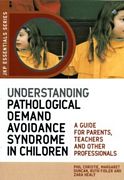
|
Understanding Pathological
Demand Avoidance Syndrome in Children: a Guide for Parents, Teachers
and Other Professionals. Phil Christie, Margaret Duncan, Ruth
Fidler & Zara Healy, $25.95
Pathological Demand Avoidance Syndrome
(PDA) is a developmental disorder that is being increasingly recognized as part
of the autism spectrum. The main characteristic is a continued resistance to
the ordinary demands of life through strategies of social manipulation, which
originates from an anxiety-driven need to be in control.
This straightforward guide is written
collaboratively by professionals and parents to give a complete overview of
PDA. Starting with an exploration into the syndrome, it goes on to answer the
immediate questions triggered when a child is first diagnosed, and uses case
examples throughout to illustrate the impact of the condition on different
areas of the child's life. Early intervention options and workable strategies
for managing PDA positively will make day-to-day life easier for the child,
their family and peers. New problems faced in the teenage years and how to
assist a successful transition from adolescence to adulthood are also tackled.
The book concludes with a valuable resources list. |
Back to top
|
|
Understanding and Supporting Pupils with Moderate
Learning Difficulties in the Secondary School: a Practical Guide. Rachel
Hayes & Pippa Whittaker, $53.95
Learners with MLD form one of the largest categories of special
educational need in mainstream secondary schools. In most schools, the vast
majority of learners with MLD will be taught in mainstream classes much of the
time. This book outlines a range of strategies and approaches for supporting
these learners. It includes all the vital information practitioners need to
know about Moderate Learning Difficulties. Key points covered include:
- Definitions and
identification of moderate learning difficulties
- Teaching
strategies and approaches
- Developing key
conceptual, literacy and social skills
- Effective
support from TAs
- Theoretical
perspectives on learning
Understanding and Supporting Pupils with Moderate Learning
Difficulties in the Secondary Schoolprovides
an introduction to a wide range of ideas, arguments and perspectives about ways
of understanding and supporting learners who are considered to have MLD. This
is a much-needed source of knowledge for teachers, TAs, SENCos, Learning
Mentors and anyone who supports children and young people with moderate
learning difficulties and provides an honest and accessible approach. |
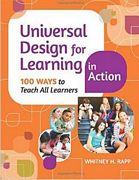
|
Universal Design for Learning in Action: 100 Ways to
Teach All Learners. Whitney Rapp, $49.50
Need creative ideas for moving UDL from theory to
practice? Get this must-have quick guide, ready for any teacher to pick up and
start using now. Whitney Rapp, co-author of the acclaimed Teaching Everyone,
walks you step by step through 100 UDL strategies that strengthen student engagement,
learning, and assessment. Based on the latest research (but still practical and
fun!), these highly effective ideas will help you address diverse learning
needs and increase all students' access to the general curriculum. Essential
for every educator who wants to know what UDL really looks like, sounds like,
and feels like — and how to use this proven approach to teach and reach all
learners.
100 UDL STRATEGIES FOR:
- Classroom space and materials: The best uses of seating,
lighting, bulletin boards, and more
- Classroom management: From smoother schedules and meetings to
effective transition areas
- Technologies: Fresh ways to use blogs, videoconferencing,
e-books, and more
- Content instruction: Teach academic content with tools like
music, drawing, mnemonics, and humor
- Social interaction: Creative games and small-group activities
that sharpen all kids’ social skills
- Executive functions: Great ideas for templates, rubrics, graphic
organizers, timers, and web-based materials
- Transition to adulthood: Prepare students for the real world with
charts, goal plans, and more
- Assessment: New ways kids can show what they know — from adapted
tests to family projects
|
Back to top
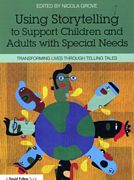
|
Using Storytelling to Support
Children and Adults with Special Needs: Transforming Lives through Telling
Tales. Edited by Nicola Grove, $49.50
This innovative and wide-ranging book
shows how storytelling can open new worlds for learners with or without special
educational needs. With sections that outline both therapeutic and educational
approaches, this practical resource provides a highly accessible combination of
theory and practice. Using STORYTELLING TO SUPPORT CHILDREN AND ADULTS WITH
SPECIAL NEEDS will be of interest to all education professionals as well
as therapists, youth workers, counsellors, and storytellers and theatre
practitioners working in special education. |
|
|
Visual Bridges for Special Learners:
a Complete Resource of 32 Differentiated Learning Activities for People with
Moderate Learning and Communication Disabilities. Julia
Moor, $79.95
Teachers and trainers running activities
for people with learning and communication difficulties face the daunting task
of balancing a wide range of needs, abilities and preferences, whilst
simultaneously being asked to meet measured outcomes, record progress and
create their own resources. This book presents thirty-two original, engaging
and highly visual learning sessions. The activities have been specifically
designed to develop learning skills, self-awareness and awareness of others,
explore representation, language and early literacy, and cooperation and
teamwork. Each session is comprehensively described and includes worksheets,
learning aims and suggestions for differentiation and extension activities for
either group work or individual learning.
These activities will help to develop
confidence and motivation by using highly visual resources to bridge the gap
between language and cognition. They will be perfect for teachers and trainers
running college classes and community education centres, day and residential
care centres and training programmes. All the worksheets are included in colour
on the accompanying CD. |
Back to top
|
|
Visual Supports for Visual Thinkers:
Practical Ideas for Students with Autism Spectrum Disorders and Other Special
Education Needs. Lisa Rogers, $52.95
Visual supports have been proven to be a
highly effective way to communicate with, and teach, a student with an autism
spectrum disorder or other learning difficulty. This book is packed with
simple, effective tools to assist in the education of students with special
education needs. They can be adapted to be used with young children and older
learners with a range of educational needs, including nonverbal learners. Based
on the author's years of teaching experience, the book covers how the classroom
environment is laid out, how to use schedules and time planning aids, different
education approaches and the teaching of social rules and appropriate behavior.
All the visual supports are clearly explained alongside examples and photos
showing them in use in the classroom. The supports are also included on the
accompanying CD as blank templates. |

|
When Gifted Kids Don't Have All the Answers: How to
Meet Their Social and Emotional Needs, 2nd Edition. Judy Galbraith &
Jim Delisle, $34.99
Gifted kids are so much more than test scores and grades.
Still, it’s sometimes difficult to see past the potential to the child who may
be anxious, lonely, confused, or unsure of what the future might bring. This
book, now fully revised with updated information and new survey quotes, offers
practical suggestions for addressing the social and emotional needs of gifted
students. The authors present ways to advocate for gifted education; help
gifted underachievers, perfectionists, and twice-exceptional students; and
provide all gifted kids with a safe, supportive learning environment.
Complete
with engaging stories, strategies, Q&As, essays, activities, resources, and
discussions of ADHD, Asperger’s, and the Common Core, this book is for anyone
committed to helping gifted students thrive. Online digital content includes
reproducible forms from the book. |
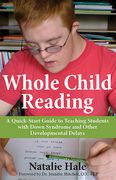
|
Whole Child Reading: a Quick Start Guide to Teaching
Students with Down Syndrome and Other Developmental Delays. Natalie Hale,
$24.95
Discover the keys to teaching children and adults with
Down syndrome and other developmental disabilities how to read for meaning.
Written for today's busy parents and teachers, this easy-to-use guide explains
how to "go in through the heart" to hook beginning and struggling
readers with high-interest, individualized materials — flashcards, personal
books, and modified trade books. The simple strategies described are designed
to "teach to the brain" and are based on research about how we learn
most easily and naturally.
The methods in the book can be adapted for learners of
any age who are reading at a third grade level or below. The crux of the
instructional method described in Whole Child Reading is to teach the
child to sight read for content before focusing on phonetics. The book
emphasizes providing new or struggling readers with books that are intensely
interesting to them about topics they love in order to get them excited about
reading. With the help of plentiful illustrations, author Natalie Hale explains
how best to motivate new readers using a combination of home-made and adapted
materials.
Whether or not you have any formal teaching experience,
you can easily work the reading activities described in Whole Child Reading into your child's routine at home. If you have at least five minutes a day to
spend on reading, you have enough time to get started using Whole Child
Reading! |
Back to top
|
The Whole Spectrum of Social, Motor,
and Sensory Games: Using Every Child’s Natural Love of Play to Enhance Key
Skills and Promote Inclusion. Barbara Sher, $19.95
Play is increasingly recognized by
neuroscientists and educators as a vital component in brain development,
academic success and learning social skills. In this inspiring and useful
resource, Barbara Sher provides step-by-step directions for how to use
children's natural interests at different stages of their development to help them
develop a wealth of sensory-motor and social skills. All the games have also
been designed to provide plenty of joyful opportunities for encouraging
inclusion.
- Offers strategies for helping all kids, but
especially those with special needs, to develop social, motor and sensory
skills
- Filled with simple games using common materials
that can be used by teachers, parents, and caregivers with both individual kids
and groups
- Provides explanations and examples of how the
games can aid in a child's development
- Offers parents and teachers a fun and easy way
to include all children in activities that will engage all of their senses and
promote important skills
|
|
Working with Traumatic Brain Injury in Schools: Transition,
Assessment, and Intervention. Paul Jantz, Susan Davies & Erin
Bigler, $70.95
Every day, children and adolescents worldwide return to
the educational setting having sustained a traumatic brain injury (TBI). The
possible negative consequences of TBI range from mild to severe and include
neurological, cognitive, emotional, social, and behavioral difficulties. Within
the school setting, the negative effects of TBI tend to persist or worsen over
time, often resulting in academic and social difficulties that require formal
and informal educational assistance and support. School psychologists and other
educational professionals are well-positioned to help ensure students with TBI
receive this assistance and support.
WORKING WITH TRAUMATIC BRAIN INJURY IN SCHOOLS is a
comprehensive practitioner-oriented guide to effective school-based services
for students who have experienced a TBI. It is primarily written for
school-based professionals who have limited or no neurological or
neuropsychological training; however, it contains educational information that
is useful to professionals with extensive knowledge in neurology and/or
neuropsychology. This book is also written for parents and guardians of
students with TBI because of their integral role in the transition,
school-based assessment, and school-based intervention processes |
|
YouCue Feelings: Using Online Videos for Social
Learning. Anna Vagintt, $26.95
YouCue Feelings: Using Online Videos for Social
Learning includes summaries and links to fabulous YouTube videos that
will keep your students asking for more. There are also lots of structured
activities to keep your discussions lively and fun. YouCue Feelings teaches
emotional vocabulary, improves student ability to track changes in feelings,
and builds comfort level to reflect on one’s own emotional experiences. So give
YouTube a try — there’s lots of rich material there! Specifically written for
therapists, teachers and parents of grade K-8 students. |
Back to top
Complete Booklist
Addressing the Unproductive Classroom Behaviours of
Students with Special Needs. Steve Chinn, $39.95
Apps for Autism: a Must-Have Resource for the Special
Needs Community, Revised 2nd Edition.Lois Jean Brady, $56.50
Assistive Technology in Special Education: Resources for
Education, Intervention, and Rehabilitation, 2nd Edition. Joan Green, $56.95
Assistive Technology: What Every Educator Needs to Know.
Brian Friedlander, $15.95 (Laminated Reference Guide)
The Autism Fitness Handbook: an Exercise Program to Boost
Body Image, Motor Skills, Posture, and Confidence in Children and Teens with
Autism Spectrum Disorder. David Geslak, $33.95
Autism Spectrum Disorder in the Ontario Context: an
Introduction. Kimberley Maich & Carmen Hall, $59.95
Behavior Analysis for Effective Teaching. Julie Vargas, $137.50
A Best Practice Guide to Assessment and Intervention for
Autism Spectrum Disorder in Schools, 2nd Edition. Lee Wilkinson, $33.95
Breaking Through: Using Educational Technology for
Children with Special Needs. Barbara Albers Hill, $26.50
Children with Disabilities: Reading and Writing the
Four-Blocks® Way. Karen Erickson & David Koppenhaver, $46.95
Children's Comprehension Problems in Oral and Written
Language: a Cognitive Perspective. Edited by Kate Cain and Jane Oakhill, $43.95
Commonsense Methods for Children with Special Educational
Needs, 7th Edition. Peter Westwood, $62.95
Common-Sense Classroom Management for Special Education
Teachers Grades 6-12. Jill Lindberg, et al, $46.20
Direct Behavior Rating: Linking Assessment,
Communication, and Intervention. Amy Briesch, Sandra Chafouleas, T. Chris Riley-Tillman,
et al, $48.50
Drama Therapy and Storymaking in Special Education. Paula
Crimmens, $37.95
EDM: the Educator's Diagnostic Manual of Disabilities and
Disorders. Roger Pierangelo & George Giuliani, $54.99
Educating Children with Life-Limiting Conditions: a
Practical handbook for Teachers and School-Based Staff. Alison Ekins, Sally
Robinson, Ian Durant & Kathryn Summers, $60.10
Educating Children and Young People with Acquired
Brain Injury, 2nd Edition. Sue Walker & Beth Wicks, $44.70
Embracing Disabilities in the Classroom: Strategies to
Maximize Students' Assets. Toby Karten, $30.99
Empowering Students with Hidden Disabilities: a Path to
Pride and Success. Margo Vreeburg Izzo & LeDerick Horne, $35.95
Engaging Learners with Complex Learning Difficulties and
Disabilities: a Resource Book for Teachers and Teaching Assistants. Barry
Carpenter, et al, $66.50
Everyday Classroom Strategies and Practices for
Supporting Children with Autism Spectrum Disorders. Jamie Bleiweiss, Lauren
Hough & Shirley Cohen, $47.95
Executive Function in Education: From Theory to
Practice, 2nd Edition. Lynn Meltzer, editor, $46.95
Back to top
Fine Motor Skills for Children with Down Syndrome: a
Guide for Parents and Professionals, 3rd Edition. Maryanne Bruni, $32.50
FISH: Functional Independence Skills Handbook. William
Killion, $115.95 (Complete FISH Kit includes the Assessment and Curriculum Handbook
and 10 Assessment Booklets)
Frequently Asked Questions about Response to
Intervention: a Step-by-Step Guide for Educators. Roger Pierangelo & George
Giuliani, $41.95
From Gobbledygook to Clearly Written Annual IEP Goals.
Barbara Bateman, $32.95
Getting the Most Out of IEPs: an Educator's Guide to the
Student-Directed Approach. Colleen Thoma & Paul Wehman, $34.95
Getting Started: iPads 4 Special Needs. Sami Rahman,
$27.50
A Guide to Duchenne Muscular Dystrophy: Information
and Advice for Teachers and Parents. Edited by Janet Hoskin, $29.95
A Guide to Writing Social Stories™: Step-by-Step
Guidelines for Parents and Professionals. Chris Williams & Barry Wright,
$28.95
Helping Children to Improve Their Gross Motor Skills: the
Stepping Stones Curriculum. Rachel White, $49.95
Identifying Children with Special Needs: Checklists and
Action Plans for Teachers. Glynis Hannell, $71.50
Identifying Special Needs: Checklists for Profiling
Individual Differences, 2nd Edition. Glynis Hannell, $50.50
The IEP Checklist: Your Guide to Creating Meaningful and
Compliant IEPs. Kathleen Winterman & Clarissa Rosas, $48.50
The IEP from A to Z: How to Create Meaningful and
Measurable Goals and Objectives. Diane Twachtman-Cullen & Jennifer
Twachtman-Bassett, $35.95
Individualized Supports for Students with Problem
Behaviors: Designing Positive Behavior Plans. Linda Bambara & Lee Kern, $65.95
Inspiring and Creative Ideas for Working with Children:
How to Build Relationships and Enable Change. Deborah Plummer, $27.95
Instructional Practices for Students with Behavioral
Disorders: Strategies for Reading, Writing and Math. J. Ron Nelson, Gregory
Benner & Paul Mooney, $28.50
Involving Parents of Students with Special Needs: 25
Ready-to-Use Strategies. Jill Dardig, $30.99 (PK - 12)
Literacy for Visual Learners: Teaching Children with
Learning Differences to Read, Write, and Communicate. Adele Devine, $49.95
Making Math Accessible to Students with Special Needs:
Practical Tips and Suggestions, Grades K-2. $33.50
Making Math Accessible to Students with Special Needs:
Practical Tips and Suggestions, Grades 3-5. $33.50
Making Math Accessible to Students with Special Needs:
Practical Tips and Suggestions, Grades 6-8. $33.50
Making Math Accessible to Students with Special Needs:
Practical Tips and Suggestions, Grades 9-12. $33.50
Back to top
Meeting Special Educational Needs in Secondary
Classrooms: Inclusion and How to Do It, 2nd Edition. Sue Briggs, $57.95
Moment to Moment: a Positive Approach to Managing
Classroom Behavior. Joey Mandel, $24.95
100 Learning Games for Special Needs with Music,
Movement, Sounds and...Silence. Johanne Hanko, $31.95
PANDAS and PANS in School Settings: a Handbook for
Educators. Edited by Patricia Rice Doran, $30.95
Paraeducator’s Resource Guide. Nancy French, $13.95
(laminated resource guide)
The Paraprofessional's Guide to Effective Behavioral
Intervention. Betty Ashbaker & Jill Morgan, $53.95
Positive Discipline for Children with Special Needs:
Raising and Teaching All Children to Become Resilient, Responsible and
Respectful. Jane Nelsen, Steven Foster & Arlene Raphael, $20.95
The Power of Peers in the Classroom: Enhancing Learning
and Social Skills. Edited by Karen Harris & Lynn Meltzer, $47.50
Practical Mathematics for Children with an Autism
Spectrum Disorder and Other Developmental Delays. Jo Adkins & Sue Larkey,
$49.95
Pre-Referral Intervention Manual (PRIM): the Most Common
Learning and Behavior Problems Encountered in the Educational Environment, 4th
Edition. Stephen McCarney et al, $83.95
Promoting Successful Transition to Adulthood for Students
with Disabilities. Robert Morgan & Tim Riesen, $48.50
Recognize, Respond, Report: Preventing and Addressing
Bullying of Students with Special Needs. Lori Ernsperger, $39.50 (K-12)
The Sensory Detective Curriculum Discovering Sensory
Processing and How It Supports Attention, Focus, and Regulation Skills. Paula
Aquilla, $33.50
Show Me! A Teacher's Guide to Video Modelling. Carol
Dittoe & Heather Bridgman, $27.95
Simple Low-Cost Games and Activities for Sensorimotor
Learning: a Sourcebook of Ideas for Young Children Including Those with Autism,
ADHD, Sensory Processing Disorder, and Other Learning Differences. Lisa Kurtz,
$29.95
63 Tactics for Teaching Diverse Learners Grades 6-12. Bob
Algozzine, Pam Campbell & Adam Wang, $30.99
Social Skills Games & Activities for Kids with
Autism. Wendy Ashcroft, Angela Delloso & Anne Marie Quinn, $30.95
Special Education Case Studies for Ontario Classrooms.
Kimberly Maich & Randy Hill, $49.95
Special Education in Ontario Schools, 7th Edition. Sheila
Bennett & Don Dworet with Ken Weber, $43.95
The Special Educator's Book of Lists. Roger Pierangelo, $62.00
The Special Educator's Comprehensive Guide to 301 Diagnostic
Tests, Revised and Expanded Edition. Roger Pierangelo & George Giuliani, $55.00
The Special Educator's Survival Guide, 2nd Edition. Roger
Pierangelo, $39.99
The Special Educator’s Toolkit: Everything You Need to
Organize, Manage, & Monitor Your Classroom. Cindy Golden, $43.95
Specific Learning Difficulties: What Teachers Need to
Know. Diana Hudson, $25.95
Starting with Their Strengths: Using the Project Approach
in Early Childhood Special Education. Deborah Lickey & Denise Powers, $44.50
Story Drama in the Special Needs Classroom: Step-by-Step
Lesson Plans for Teaching through Dramatic Play. Jessica Perich Carleton, $31.95
Back to top
Strategies to Support Children with Autism and Other
Complex Needs: Resources for Teachers, Support Staff, and Parents. Christine
Macintyre, $50.30
Supporting Children with Autistic Spectrum Disorders, 2nd
Edition. Elizabeth Morling & Colleen O'Connell, $47.50
Supporting Children with Cerebral Palsy, 2nd Edition. Rob
Grayson, et al, $47.50
Supporting Pupils on the Autism Spectrum in Primary
Schools: a Practical Guide for Teaching Assistants. Cary Canavan, $57.50
Supporting Pupils on the Autism Spectrum in Secondary
Schools. Cary Canavan, $62.90
A Survival Guide for New Special Educators, Grades K-12.
Bonnie Billingsley, Mary Brownell, Maya Israel & Margaret Kamman, $35.95
Swivel to Success: Bipolar Disorder in the Classroom.
Tracy Anglada, $18.95
Systematic Instruction for Students with Moderate and
Severe Disabilities. Belva Collins, $63.50
Talkabout Sex & Relationships 1: a Programme to
Develop Intimate Relationship Skills. Alex Kelly & Emily Dennis, $72.70
Taming The Data Monster: Collecting and Analyzing
Classroom Data to Improve Student Progress. Christine Reeve & Susan Kabot,
$45.95
Teaching Adolescents with Autism: Practical Strategies
for the Inclusive Classroom. Walter Kaweski, $22.95
Teaching by Design: Using Your Computer to Create
Materials for Students with Learning Differences. Kimberly Voss, $47.50
Teaching Disability Sport, 2nd Edition. Ronald Davis,
$54.95
Teaching Gifted Children with Special Educational Needs:
Supporting Dual and Multiple Exceptionality. Diane Montgomery, $57.95
Teaching Kids with Mental Health & Learning Disorders
in the Regular Classroom: How to Recognize, Understand and Help Challenged (and
Challenging) Students Succeed. Myles Cooley, $51.99
Teaching the Moving Child: OT Insights that Will
Transform Your K-3 Classroom. Sybil Berkey, $46.50
Understanding Pathological Demand Avoidance Syndrome in Children:
a Guide for Parents, Teachers and Other Professionals. Phil Christie, Margaret
Duncan, Ruth Fidler & Zara Healy, $25.95
Understanding and Supporting Pupils with Moderate
Learning Difficulties in the Secondary School: a Practical Guide. Rachel Hayes
& Pippa Whittaker, $53.95
Universal Design for Learning in Action: 100 Ways to
Teach All Learners. Whitney Rapp, $49.50
Using Storytelling to Support Children and Adults with
Special Needs: Transforming Lives through Telling Tales. Edited by Nicola Grove,
$49.50
Visual Bridges for Special Learners: a Complete Resource
of 32 Differentiated Learning Activities for People with Moderate Learning and
Communication Disabilities. Julia Moor, $79.95
Visual Supports for Visual Thinkers: Practical Ideas for Students
with Autism Spectrum Disorders and Other Special Education Needs. Lisa Rogers,
$52.95
When Gifted Kids Don't Have All the Answers: How to Meet
Their Social and Emotional Needs, 2nd Edition. Judy Galbraith & Jim
Delisle, $34.99
Whole Child Reading: a Quick Start Guide to Teaching
Students with Down Syndrome and Other Developmental Delays. Natalie Hale, $24.95
The Whole Spectrum of Social, Motor, and Sensory Games:
Using Every Child’s Natural Love of Play to Enhance Key Skills and Promote
Inclusion. Barbara Sher, $19.95
Working with Traumatic Brain Injury in Schools:
Transition, Assessment, and Intervention. Paul Jantz, Susan Davies & Erin
Bigler, $70.95
YouCue Feelings: Using Online Videos for Social Learning.
Anna Vagintt, $26.95
Back to top

Didn't
find it...?
Not sure...?
Need a suggestion...?
There are over 10,000 titles listed on our website and more than 35,000 titles in our inventory. If you haven't found what you want on the website — and it's one of our specialties — chances are good that we carry it, or can get it for you. Just let us know what you're looking for.
Call us toll-free 1-800-209-9182
or e-mail
PARENTBOOKS
is pleased to invoice institutions. Please inquire regarding terms and
discounts. Shop in person, by phone, fax, mail or e-mail . VISA, Mastercard
and Interac are welcome. We are open from 10:30 to 6:00 Monday through Friday and from 11:00 to 5:00 on Saturday.
 All prices are in Canadian dollars
and are subject to change without notice. All prices are in Canadian dollars
and are subject to change without notice.

|